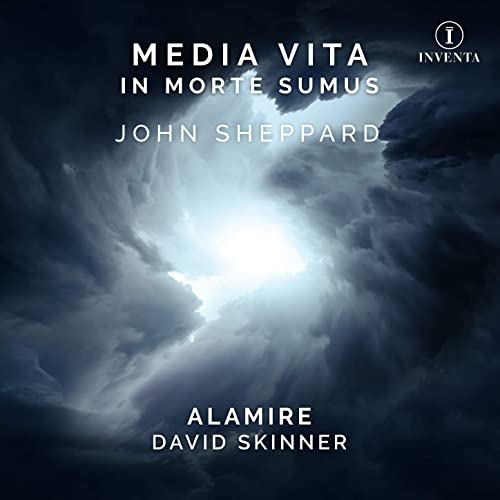Alamire, David Skinner
16:30
Inventa INV1003
Click HERE to buy this on amazon.co.uk (from July 17th!)
“Beyond glorious … monumental”. These words are used by David Skinner, director of Alamire, in his notes accompanying this recording, to describe – without one atom of exaggeration – the music of John Sheppard in general and his antiphon Media vita in morte sumus in particular. Another word, sublime, has been worked near to death (sic) in recent decades, but in its essential meaning it too applies to this work. Indeed, no praise can be too high for this musical creation. It is one of those few works that one feels could almost represent Creation itself. It has been recorded a number of times over recent decades by a variety of distinguished ensembles, and here, another of the finest choirs in the realm performs this incomparable masterpiece, but in a new version never before recorded. At just over sixteen measured but purposeful minutes it is about half the length of the longest rendition of the hitherto accepted format, a riveting tour de force by the Choir of Westminster Cathedral (Hyperion CDA68187). And this is the point: between themselves, as David explains in his excellent notes, he and two other distinguished musicologists, Jason Smart and John Harper, have arrived at the conclusion that Sheppard’s musical volcano should consist of fewer repetitions than the version hitherto accepted and recorded, not shedding any of the actual music and retaining much of the chant, simply ordered differently. The recording itself dates from 2012, when Alamire was involved in a project for BBC television which featured an eminent historian who, in the current cultural climate, cannot be named (clue: he is No Relation of The Beatles’ drummer) but a commercial recording was not released at the time. It is an ill wind that blows nobody any good, and reworking of the audio files, from what was the previously accepted version, “happened during the Covid-19 lockdown” resulting in this premiere of what could well be the version of his masterwork that Sheppard might have expected to hear. Notwithstanding the evidence imparted by David, it is perhaps not impossible that there will be those who maintain the integrity of the previously accepted format. Pace David’s surprising defensiveness about “maintaining balance and interest [reviewer’s italics] in modern performance” – surely this is music of the spheres, that should be continuous and without end – this new dispensation deprives the listener of some repetitions of Sheppard’s heavenly polyphony, but then again one can always repeat the new version! Indeed, the revised format might make the work more accessible to choirs cautious about programming a single work from the 16thcentury that usually lasts 20-30 minutes. Alamire’s performance is excellent; for a choir which, as its director observes, “tend[s] to lean towards those darker sonorities” there could have been more pneumatic drill from the basses, but given the dimensions of the choir and the acoustic in which they were recorded, the pacing and blend are fine. In terms of the value of the music and the quality of the performance, not to mention the considerable amount of research behind it, this recording is a snip. It is recommended without hesitation. Don’t even wait just a minute – buy it now.
Richard Turbet
